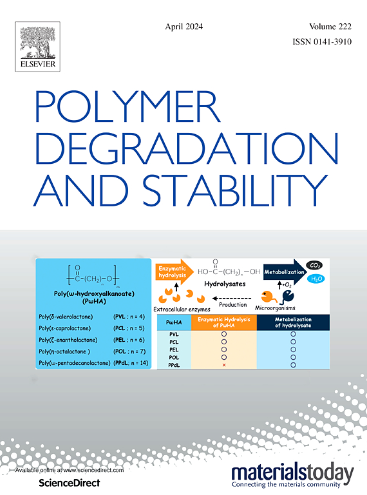研究呋喃环取代和网络位置对环氧树脂本质阻燃成焦的影响
IF 7.4
2区 化学
Q1 POLYMER SCIENCE
引用次数: 0
摘要
通常在环氧树脂中加入阻燃剂以降低其可燃性。然而,人们对从这些化学物质过渡到本质阻燃环氧树脂的兴趣越来越大。一种很有前途的方法是将呋喃掺入聚合物中,这种聚合物可以促进炭的形成。尽管如此,在最终的碳结构中,呋喃从五元环转化为六元环的化学反应仍然知之甚少。在这项工作中,开发了三种呋喃基环氧树脂,以探索呋喃环取代和网络定位如何影响呋喃二氧基(FDE),甲基呋喃二氧基(MethylFDE)和二呋喃二胺四酰基胺(TGDFDA)的碳形成。热重分析(TGA)和演化气体分析表明,呋喃环的网络位置比环取代对焦炭形成的影响更大。主链呋喃环的PolyTGDFDA在1000℃的氮气气氛下炭收率最高,为44.0±0.6%。相比之下,含有单取代呋喃环的聚氟醚的炭产率为38.6±0.7%,而含有双取代呋喃环的聚甲基氟醚的炭产率为22.4±2.1%。拉曼光谱结果表明,呋喃环取代和网络位置对炭产率有显著影响,而对生成碳的类型没有显著影响。微燃烧量热法(MCC)评价了炭产率的提高对可燃性的影响。这些呋喃基环氧树脂为开发不需要阻燃化学品的本质阻燃聚合物提供了一条途径。此外,对呋喃环在炭化过程中的作用也有了进一步的认识。本文章由计算机程序翻译,如有差异,请以英文原文为准。
Investigating the effects of furan ring substitution and network position on char formation in intrinsically flame-retardant epoxy resins
Flame-retardant chemicals are often added to epoxy resins to decrease their flammability. However, there is an increasing interest in transitioning from these chemicals to intrinsically flame-retardant epoxies. One promising approach involves incorporating furan into polymers, which is known to enhance char formation. Nonetheless, the chemical reactions that allow furan to convert from five-membered rings to six-membered rings in the final carbon structure remain poorly understood. In this work, three furan-based epoxy resins were developed to explore how furan ring substitution and network positioning affect char formation: furan diepoxy (FDE), methyl furan diepoxy (MethylFDE), and tetraglycidyl amine of difuran diamine (TGDFDA). Thermogravimetric analysis (TGA) and evolved gas analysis showed that the network position of the furan ring has a greater impact on char formation than ring substitution. PolyTGDFDA, which has main-chain furan rings, had the highest char yield of 44.0 ± 0.6 % at 1000 °C in a nitrogen atmosphere. In contrast, PolyFDE, containing pendant, monosubstituted furan rings, displayed a char yield of 38.6 ± 0.7 %, while PolyMethyl-FDE, with pendant, disubstituted furan rings, yielded 22.4 ± 2.1 %. The influence of furan ring substitution and network position significantly impacted the char yield, but not the type of carbon formed, as shown by Raman spectroscopy. The enhanced char yields positively affected the flammability performance, as evaluated by micro-combustion calorimetry (MCC). These furan-based epoxies showed a path toward developing intrinsically flame-retardant polymers without needing flame-retardant chemicals. Furthermore, insights into the role of furan rings during char formation were developed.
求助全文
通过发布文献求助,成功后即可免费获取论文全文。
去求助
来源期刊

Polymer Degradation and Stability
化学-高分子科学
CiteScore
10.10
自引率
10.20%
发文量
325
审稿时长
23 days
期刊介绍:
Polymer Degradation and Stability deals with the degradation reactions and their control which are a major preoccupation of practitioners of the many and diverse aspects of modern polymer technology.
Deteriorative reactions occur during processing, when polymers are subjected to heat, oxygen and mechanical stress, and during the useful life of the materials when oxygen and sunlight are the most important degradative agencies. In more specialised applications, degradation may be induced by high energy radiation, ozone, atmospheric pollutants, mechanical stress, biological action, hydrolysis and many other influences. The mechanisms of these reactions and stabilisation processes must be understood if the technology and application of polymers are to continue to advance. The reporting of investigations of this kind is therefore a major function of this journal.
However there are also new developments in polymer technology in which degradation processes find positive applications. For example, photodegradable plastics are now available, the recycling of polymeric products will become increasingly important, degradation and combustion studies are involved in the definition of the fire hazards which are associated with polymeric materials and the microelectronics industry is vitally dependent upon polymer degradation in the manufacture of its circuitry. Polymer properties may also be improved by processes like curing and grafting, the chemistry of which can be closely related to that which causes physical deterioration in other circumstances.
 求助内容:
求助内容: 应助结果提醒方式:
应助结果提醒方式:


